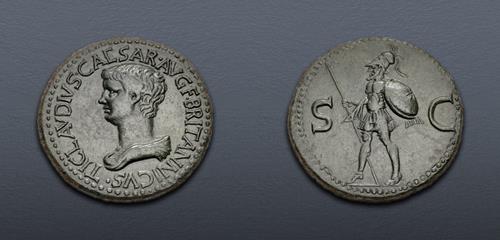
|
Britannicus. AD 41-55. Æ Sestertius (36.5mm, 26.52 g, 6h). Uncertain Balkan/Thracian mint. Struck under Claudius, AD 50-54.
Triton XXV
Lot: 805. Estimated: $ 30 000
Roman Imperial, Bronze, Coin-in-Hand Video
Sold For $ 58 000. This amount does not include the buyer’s fee.
Go to Live
|
|
Britannicus. AD 41-55. Æ Sestertius (36.5mm, 26.52 g, 6h). Uncertain Balkan/Thracian mint. Struck under Claudius, AD 50-54. TI CLAVDIVS • CAESAR • AVG • BRITANNICVS •, bareheaded and draped bust left / S C across field, Mars, wearing crested Corinthian helmet, cuirass, and short tunic, advancing left, holding transverse spear in extended right hand, and in left, shield, decorated with star motif as the central boss. RIC I p. 130 note; von Kaenel, Thrakien Type B, B8, pl. 21, 8; BMCRE 226 (Claudius); BN –. Lovely dark green patina. Good VF. Well centered and struck. Very rare and in extraordinary condition. Certainly among the finest known examples.
Ex Numismatica Ars Classica 100 (29 May 2017), lot 440 (hammer 50,000 CHF).
Tiberius Claudius Germanicus was born on 12 February AD 41, only a few weeks after his father, Claudius, became emperor. After Claudius' conquest of Britain in AD 43, the boy's name was changed to Tiberius Claudius Caesar Britannicus, and the sources refer to him simply as Britannicus. In AD 55, while dining with friends, he was poisoned and died. The murder was almost certainly ordered by Nero, who wanted to clear the way for his own succession to the throne.
The attribution of Britannicus’ sestertii has been a matter of some controversy. In earlier scholarship, the issue had been attributed to Rome around the end of Claudius’ reign when Britannicus adopted the toga virilis. Mattingly demonstrated that such an attribution was problematic, as the Roman mint was not producing aes at that time, and he assigned the type instead to the early years of Titus, when many restoration and commemorative issues were being struck. More recently, substantial numbers of Latin coins (sestertii and dupondii) in the name of Britannicus, Agrippina Jr., Nero Caesar, and Nero Augustus have been found localized in the Balkan region, and von Kaenel argued for a Thracian origin for the series. Von Kaenel’s analysis must be correct, for the style and fabric of the coins, as well as the find spots, indicate a Thracian mint, and there is nothing in the types or legends to suggest that any of these coins are posthumous. These local issues would have been struck for use by the legions servicing the border.
|
